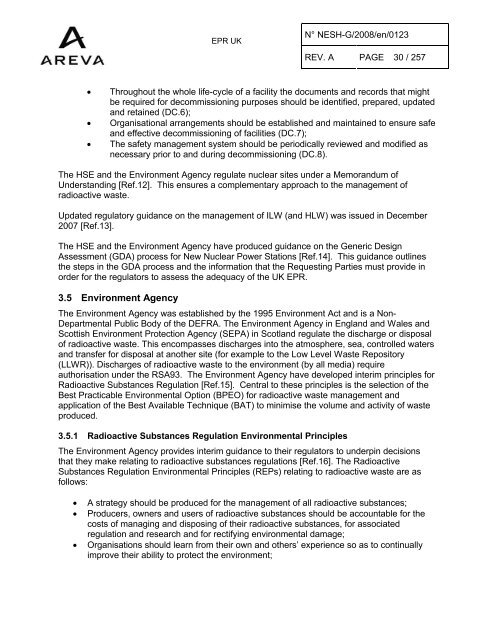Solid Radioactive Waste Strategy Report.pdf - UK EPR
Solid Radioactive Waste Strategy Report.pdf - UK EPR
Solid Radioactive Waste Strategy Report.pdf - UK EPR
Create successful ePaper yourself
Turn your PDF publications into a flip-book with our unique Google optimized e-Paper software.
<strong>EPR</strong> <strong>UK</strong><br />
N° NESH-G/2008/en/0123<br />
REV. A PAGE 30 / 257<br />
· Throughout the whole life-cycle of a facility the documents and records that might<br />
be required for decommissioning purposes should be identified, prepared, updated<br />
and retained (DC.6);<br />
· Organisational arrangements should be established and maintained to ensure safe<br />
and effective decommissioning of facilities (DC.7);<br />
· The safety management system should be periodically reviewed and modified as<br />
necessary prior to and during decommissioning (DC.8).<br />
The HSE and the Environment Agency regulate nuclear sites under a Memorandum of<br />
Understanding [Ref.12]. This ensures a complementary approach to the management of<br />
radioactive waste.<br />
Updated regulatory guidance on the management of ILW (and HLW) was issued in December<br />
2007 [Ref.13].<br />
The HSE and the Environment Agency have produced guidance on the Generic Design<br />
Assessment (GDA) process for New Nuclear Power Stations [Ref.14]. This guidance outlines<br />
the steps in the GDA process and the information that the Requesting Parties must provide in<br />
order for the regulators to assess the adequacy of the <strong>UK</strong> <strong>EPR</strong>.<br />
3.5 Environment Agency<br />
The Environment Agency was established by the 1995 Environment Act and is a Non-<br />
Departmental Public Body of the DEFRA. The Environment Agency in England and Wales and<br />
Scottish Environment Protection Agency (SEPA) in Scotland regulate the discharge or disposal<br />
of radioactive waste. This encompasses discharges into the atmosphere, sea, controlled waters<br />
and transfer for disposal at another site (for example to the Low Level <strong>Waste</strong> Repository<br />
(LLWR)). Discharges of radioactive waste to the environment (by all media) require<br />
authorisation under the RSA93. The Environment Agency have developed interim principles for<br />
<strong>Radioactive</strong> Substances Regulation [Ref.15]. Central to these principles is the selection of the<br />
Best Practicable Environmental Option (BPEO) for radioactive waste management and<br />
application of the Best Available Technique (BAT) to minimise the volume and activity of waste<br />
produced.<br />
3.5.1 <strong>Radioactive</strong> Substances Regulation Environmental Principles<br />
The Environment Agency provides interim guidance to their regulators to underpin decisions<br />
that they make relating to radioactive substances regulations [Ref.16]. The <strong>Radioactive</strong><br />
Substances Regulation Environmental Principles (REPs) relating to radioactive waste are as<br />
follows:<br />
· A strategy should be produced for the management of all radioactive substances;<br />
· Producers, owners and users of radioactive substances should be accountable for the<br />
costs of managing and disposing of their radioactive substances, for associated<br />
regulation and research and for rectifying environmental damage;<br />
· Organisations should learn from their own and others’ experience so as to continually<br />
improve their ability to protect the environment;

















